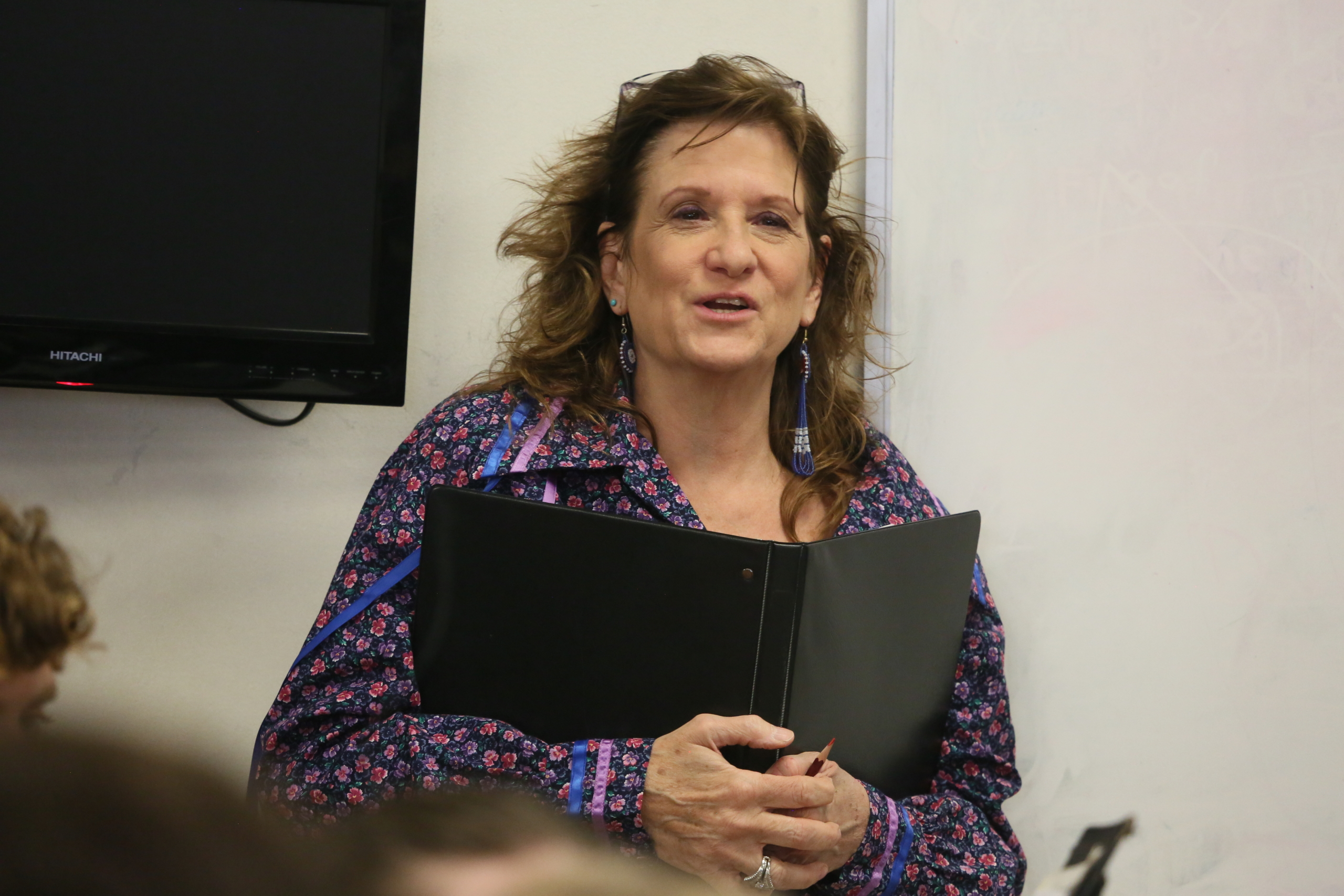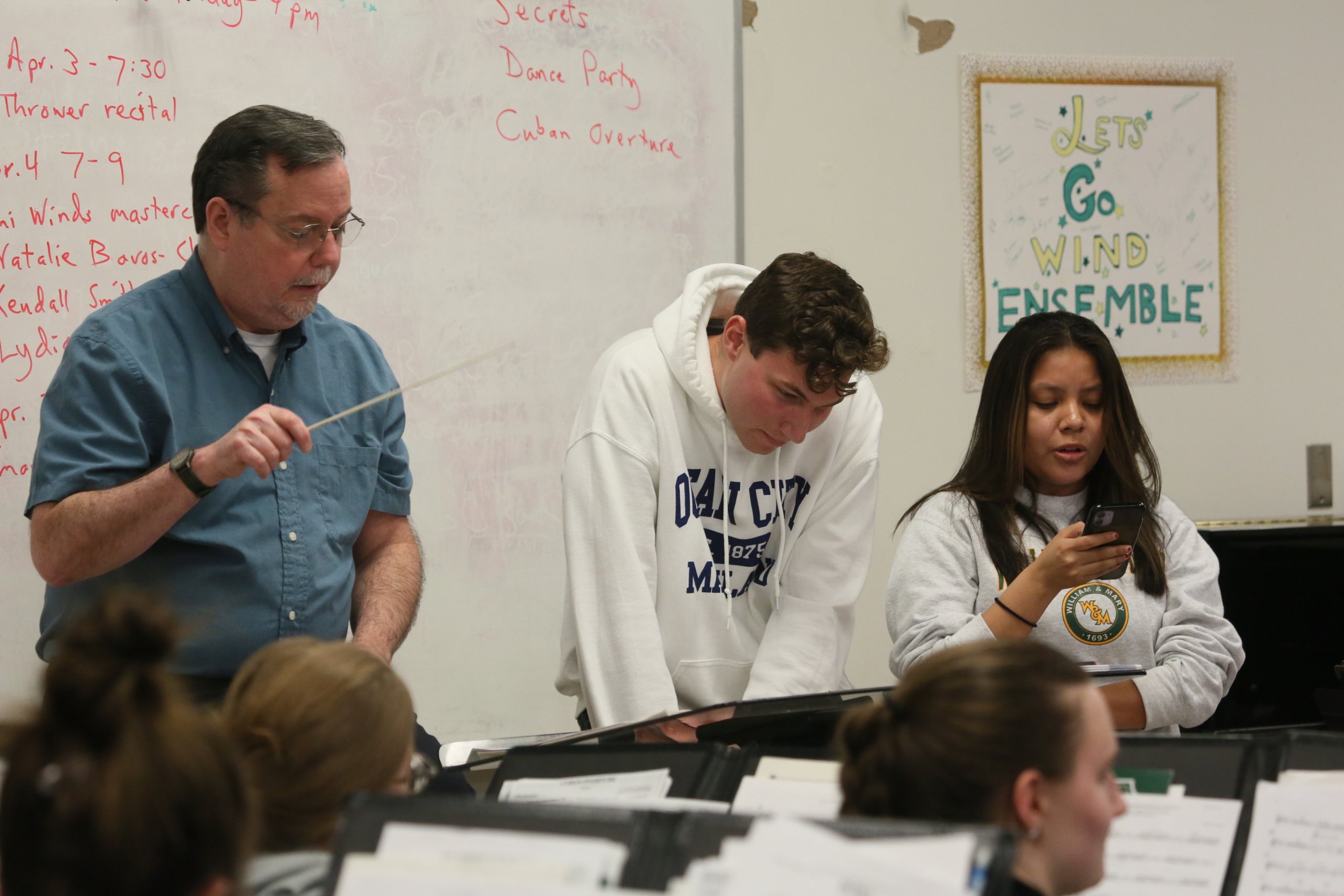Sounds of wind, clicks, drumbeats and rattles reverberated around Ewell Hall as Dawn Avery gave suggestions to two William & Mary musical groups rehearsing scores she had written.
“Not too polite,” Avery suggested at one point, indicating instruments should be struck less precisely. “It’s all the people from this land coming out to walk around and greet you; the ancestors are here.”
Avery was commissioned to write pieces for the Wind Ensemble and Gallery Players by the Class of 1939 Maurine Stuart Dulin Artist-in-Residence program in the music department as part of W&M’s commemoration of the 300th anniversary of the Brafferton Indian School.
The year-long commemoration kicked off in February at the university’s Charter Day ceremony and aims to share a more complete history of the Brafferton Indian School at W&M. Led by the Office of Strategic Cultural Partnerships, the Brafferton Initiative includes collaborative work with tribal communities, faculty initiatives and a variety of campus and community events — including two upcoming musical performances.
The Gallery Players conductor-less chamber orchestra will debut “Indian Territory” at its spring concert April 27 at 8 p.m. at Bruton Parish Church. The Wind Ensemble will premiere “Secrets Ohsatstenhserón:ni” at its spring concert May 3 at 7:30 p.m. in Sadler Center Commonwealth Auditorium, with a preview April 26. Ohsatstenhserón:ni means secrets in the Mohawk language.
“I have listened to Dawn Avery’s music before,” said Rachel Sawyer ’26, who plays trumpet in the Wind Ensemble. “I have always found it engaging and enjoyable to hear, so I was excited when I found out that the Wind Ensemble would be performing a piece that she wrote for the group.
“Before we rehearsed the music for the first time, Professor Richard Marcus told the story behind the work and how the unique musical attributes added to it.”
Creating Indigenous soundscapes
Avery, who is of Mohawk descent, is a Grammy-nominated cellist, composer and vocalist who is professor of music at Montgomery College in Maryland. She is committed to Indigenous language and cultural preservation, including looking for ways to decolonize or Indigenize traditional types of music.
“I usually have something different for orchestra,” Avery said, explaining the example of musicians speaking names of Indigenous tribes in Virginia while playing “Indian Territory.”
“Its proud strength is meant to welcome us all in acknowledging who came before us and the ancestors that remain with us. Within the work, the players are asked to recite and sing the names of the local tribes, thus honoring their land and presence.”

In November, Avery spent several days interacting with students at rehearsals and in classes, as well as a Ewell Concert Series performance. Her year-long residency continued when she returned March 29 to coach both groups in their rehearsal of the commissioned pieces.
“The Wind Ensemble is looking forward to premiering Dawn Avery’s ‘Secrets Ohsatstenhserón:ni,’” said Marcus, director of the Wind Ensemble. “The work’s connection to William & Mary’s past makes this event quite special. The techniques that Dawn uses to represent the ancestors’ spirits — for example key clicks, slap tone and air through the instruments — are quite evocative.”
Danielle Moretti-Langholtz, Thomasina E. Jordan Director of the American Indian Resource Center, wrote a historical text that is read during one part of “Secrets.” American Indian Student Association members Matthew Solomon ’24, Dakota Kinsel ’26 and Grace Cogley ’25 will serve as narrators.
Moretti-Langholtz pulled material from research she and Buck Woodard Ph.D. ’13 did for their edited volume “Building the Brafferton: The Founding, Funding and Legacy of America’s Indian School.”
“The text names the various tribes who sent their sons to the school and names the actions of four of the students,” Moretti-Langholtz said.
Avery incorporated what she likes to call “Indigenous soundscapes” into “Secrets,” she said.
“These include a variety of rattles whose sound is reminiscent of social dances and ceremony,” Avery said. “A powwow drum is represented by the sounds of a bass drum or timpani. At certain points, the drummer plays ‘honor beat’ accents typical of powwow drum songs.
“Rattle sounds are also heard by the instrumentalists who are asked to use contemporary techniques of key clicks and key rattles to symbolize the secrets, while slap tones and slap tongues are employed to represent drum accents and secrets waiting to be told.”
Educational opportunity for students
Learning a different type of composition has been a unique and meaningful experience for students.
“When we played the first notes, the key clicks and the whooshing sounds of the wind players sent a shiver down my spine,” Sawyer said. “I felt as if I had been transported into the story Dawn Avery was telling through her music.
“’Secrets’ is now a piece I look forward to rehearsing in Wind Ensemble, and I will be forever grateful to have the experience of performing this piece. I am honored to be a part of making this story alive.”

Samuel Chenkin ’25 is the lone string bass player in the Wind Ensemble, which means music often doesn’t contain dedicated parts for his instrument and he plays parts written for tuba. He was thrilled and honored to see that Avery had written a part especially for the bass, which is unique and adds a completely different sound, he said.
“All of the sounds and notes are important to ‘Secrets,’ and Dawn Avery composed it in such a way in which each sound and instrument takes center stage at some point,” Chenkin said. “That being said, the most important part is the narration given in the latter half of the piece.”
At the Gallery Players’ rehearsal, Avery showed cello and violin players how to turn their bows over and bounce them on the strings to make a desired sound. These were among the many subtle tweaks and changes exchanged as she and students worked through sections of music in both rehearsals, asking and answering one another’s questions and fine-tuning the pieces.
“The Gallery Players are honored to be premiering Dawn Avery’s ‘Indian Territory’ for the 300th anniversary of the Brafferton Indian School at W&M,” said Susan Via, instructor of violin and director of the Gallery Players. “Professor Avery’s creative use of specific string instrument techniques enables the ensemble to produce musical nuances and expressive sounds to describe the heritage of regional Indigenous peoples.
“The speaking and singing indications during the piece, which are excitingly out of the box for us, further create new layers of musical texture and personal engagement by the performers. ‘Indian Territory’ is awe inspiring and thought provoking; it is a beautifully descriptive work. The Gallery Players are thoroughly enjoying their exploration of this piece and preparing it for performance, and they are thrilled to have the experience of coaching with the composer.”
Jennifer L. Williams, Communications Specialist

